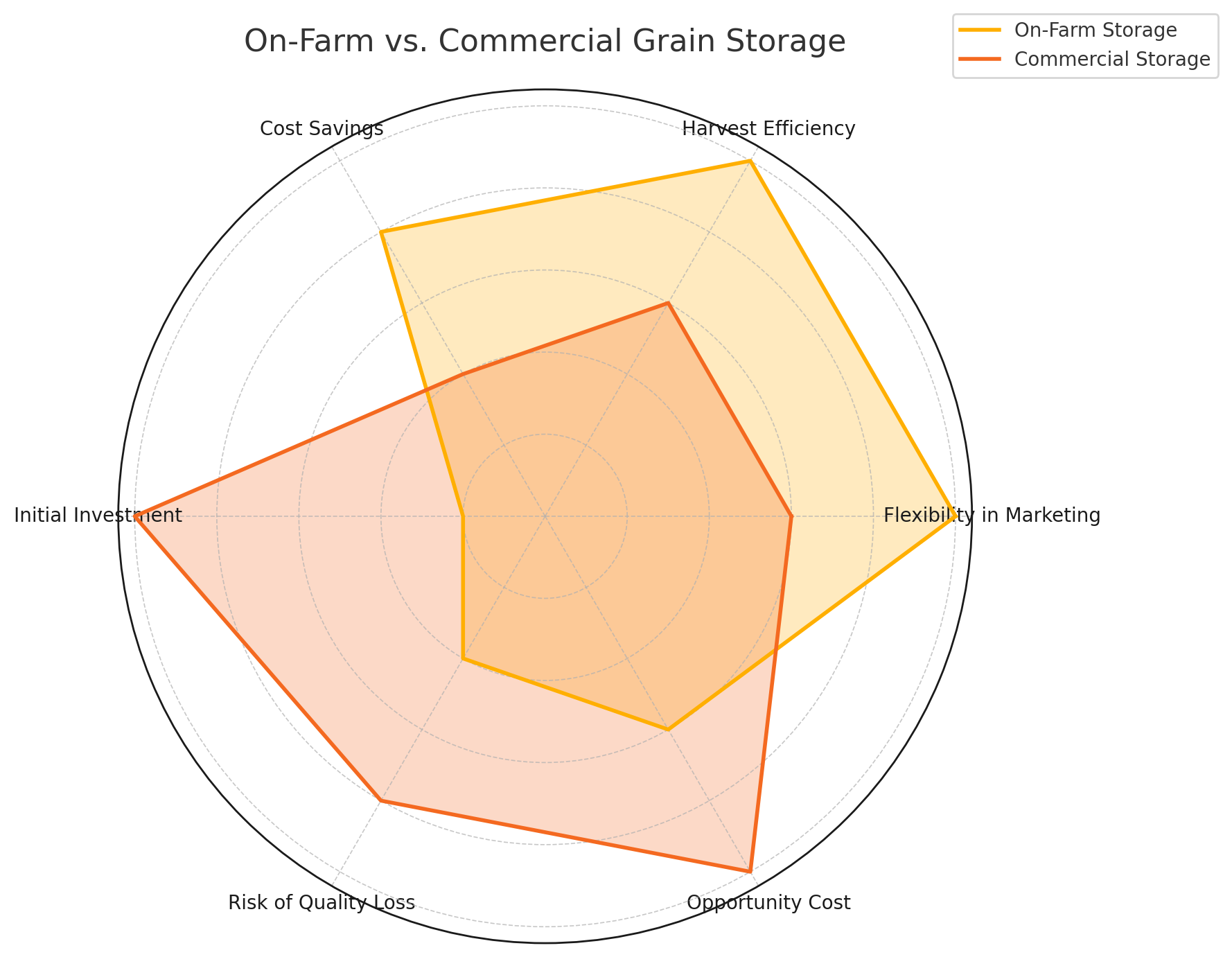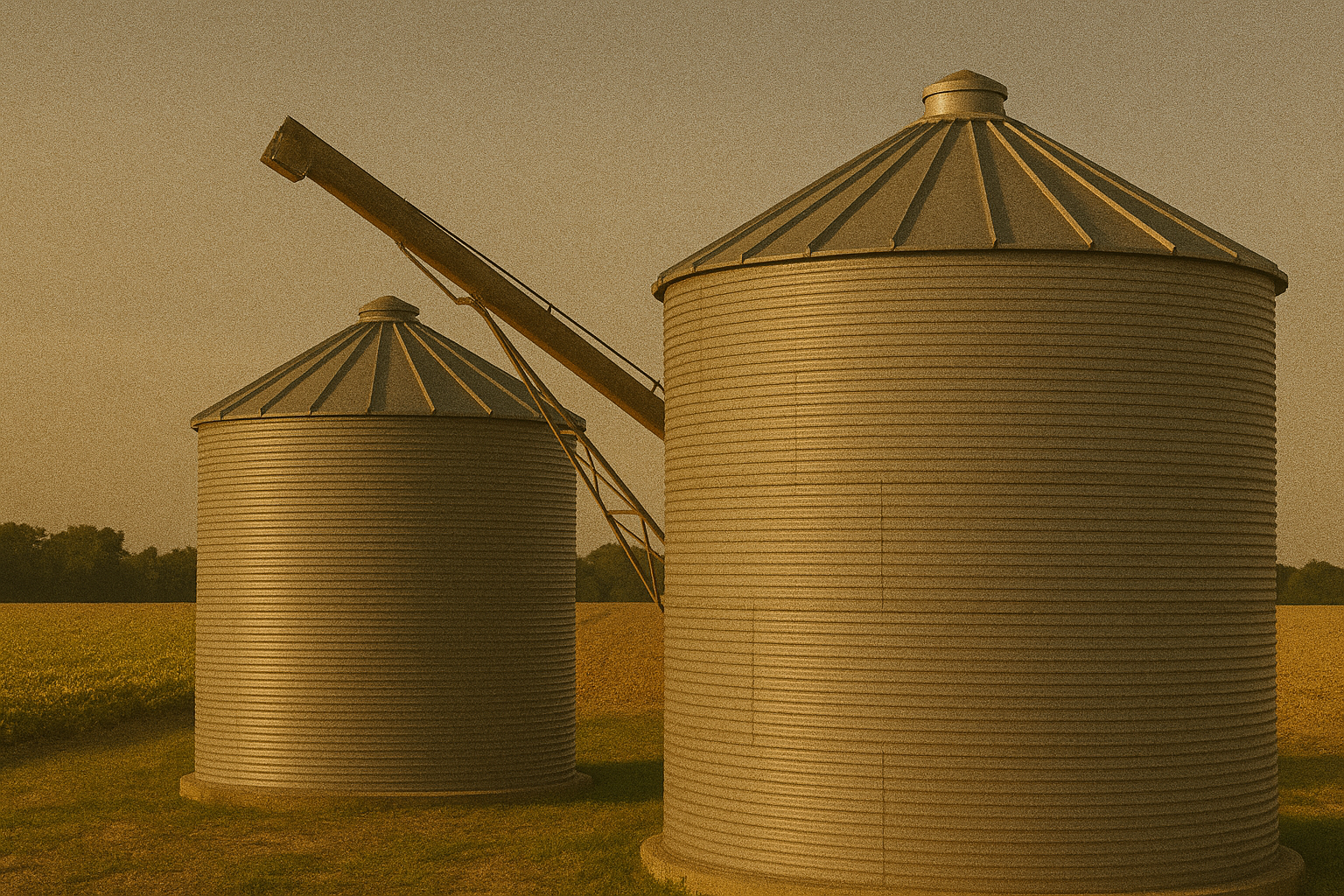To Store or Not to Store: The Pros and Cons of Grain Storage
Introduction
Harvest time presents farmers with a critical decision: should you store your grain or sell it immediately? This choice can significantly impact your farm's profitability, cash flow, and risk management. Understanding the advantages and disadvantages of grain storage as a lever in your overall grain marketing strategy is essential, whether you have on-farm storage facilities or rely on commercial options.
Perspective 1: Farmers With On-Farm Storage
Pros
- Flexibility in Marketing
On-farm storage allows you to hold onto your grain post-harvest, giving you the flexibility to sell when market prices are more favorable. This strategy can help you avoid the typically lower prices during the harvest glut. - Reduced Harvest Pressure
Storing grain on-site can streamline your harvest operations by reducing the need to transport grain immediately. This efficiency can save time and labor during the busy harvest season. - Cost Savings
By storing grain yourself, you can avoid commercial storage fees and potentially reduce transportation costs, especially if you can deliver directly to buyers when prices are optimal.
Cons
- Initial Investment and Maintenance
Building and maintaining on-farm storage facilities require significant capital investment. Ongoing maintenance, including pest control and equipment upkeep, adds to the cost. - Risk of Quality Loss
Improper storage conditions can lead to grain spoilage due to moisture, pests, or temperature fluctuations. Regular monitoring and management are essential to preserve grain quality. - Opportunity Cost
Capital tied up in stored grain and storage infrastructure could potentially be used elsewhere in your operation, such as investing in equipment or expanding acreage.
Perspective 2: Farmers Without On-Farm Storage
Pros
- Lower Capital Requirements
Utilizing commercial storage eliminates the need for significant upfront investment in storage infrastructure, allowing you to allocate resources to other areas of your farm. - Professional Management
Commercial storage facilities often provide professional grain management, including temperature control and pest management, which can help maintain grain quality. - Access to Marketing Tools
Many commercial elevators offer grain marketing contracts and tools, such as forward contracts and basis contracts, which can aid in price risk management.
Cons
- Storage and Handling Fees
Commercial storage comes with costs, including storage fees and potential handling charges, which can eat into your profit margins. - Less Control Over Marketing Timing
Relying on commercial storage may limit your flexibility in timing grain sales, especially if storage space is limited or if the facility requires grain to be moved at specific times. - Transportation Logistics
Transporting grain to and from commercial facilities adds logistical considerations and potential costs, particularly if facilities are located far from your farm.
Is It Worth Investing in On-Farm Storage?
For grain and commodity producers, harvest season is a race against time — and markets. Many farmers rush to sell immediately after harvest to avoid losses due to moisture, pests, or lack of space. But this often means selling at the lowest prices of the year.
That’s why more producers are considering a powerful strategy: on-farm storage. The ability to store grain on your own farm means you can:
- Store harvested crops immediately without relying on elevator availability
- Dry, clean, and monitor grain quality yourself
- Wait for more favorable market prices or basis levels
- Manage post-harvest logistics with greater independence
On-farm storage can take several forms:
- Metal silos – the most common for grains like corn, soybeans, and wheat
- Bulk warehouses or flat storage – ideal for large-scale operations
- Airtight or modified-atmosphere systems – used for higher-value or specialty crops
While the benefits are clear, the costs are real. A new grain bin system represents a substantial upfront investment and requires ongoing operational expenses. Your decision should balance potential market gains against the cost of construction, maintenance, and financing.
Key Considerations for Your Decision
- Market Outlook: Assess current and projected grain prices to determine if storing grain could lead to better returns.
- Cash Flow Needs: Consider your immediate financial obligations. Selling at harvest may provide necessary liquidity.
- Storage Costs: Calculate the total cost of storage, including construction, maintenance, or commercial fees, against potential price gains from delayed sales.
- Risk Management: Evaluate your ability to manage risks associated with grain storage, such as spoilage and market volatility.

Run the Numbers Before you Store or Sell
Before you commit to storage or an early sale, it helps to model the potential outcomes. Use our Grain Marketing Calculator to compare scenarios based on storage costs, contract types, and market timing. It’s a quick way to see which option may deliver the best ROI for your operation.
Conclusion
The decision to store or sell grain at harvest is multifaceted, involving considerations of infrastructure, market conditions, and financial needs. Farmers with on-farm storage gain flexibility and potential cost savings but face significant investment and management responsibilities. Those without storage avoid infrastructure costs but may incur higher fees and have less control over marketing timing.
If you’re evaluating whether to invest in on-farm storage, weigh the long-term strategic benefits against the financial and logistical commitments. The right choice is the one that aligns with your farm’s goals, resources, and appetite for market risk.
Farm accounting that just works.
Tired of hacking workarounds in software that wasn’t built for farms? We made Traction Ag just for you.

Agape Farms in Ohio



